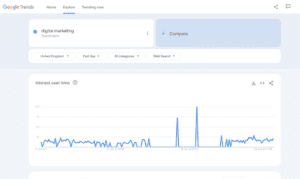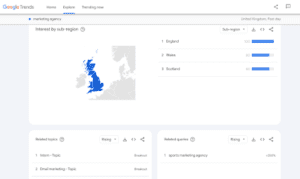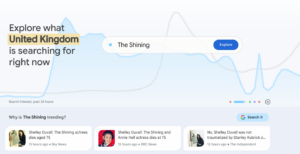
6 ways to use Google Trends for SEO and content marketing

Google, the most popular search engine in the world, and a veritable toolbox for any SEO specialist, positively brimming with tips, tricks, and useful tools that can be used to enhance any search engine optimisation strategy.
And, sitting in pride of place amongst the Google Search Console and Google Keyword Planner is Google Trends, a free tracking tool that enables users to analyse in real-time the popularity of search queries entered into Google Search on a global scale.
Google Trends can be used in SEO and content marketing to do things like identify trends in search volume, discover new and popular keywords, uncover related topics to influence your own content, and more!
Here’s how you can use Google Trends to enhance your SEO and content marketing in order to get the most out of your toolkit.
Google Trends for basic analysis
The first thing you need to do with Google Trends is to source the data you’re looking to analyse. You can do this by searching for a term on Trends which will produce an overview graph amongst other information. This graph will show the popularity over time of the search term you entered.

Source: Google Trends
In order to understand this graph, you need to be aware that the ascending numbers (up to 100) indicate the ascension in a term’s popularity. The peaks and valleys in the graph will help demonstrate seasonal patterns in the results.
How to categorize the data
You can categorise the data in the graph through four selectable customisation methods. These include:
- Geographic location (by individual country or worldwide)
- Topic categories (25 categories as well as all the categories simultaneously)
- Four different search surfaces
- Time
Other useful data on Google Trends includes interest by subregion, related topics, and related queries. These categories all allow you to identify more specific data that is useful for developing a successful marketing strategy.
1. Carry out keyword research
A fundamental aspect of any SEO strategy is producing relevant and informative content that includes keywords or search queries popular amongst your target audience. By incorporating these terms into your content, your site is more likely to rank higher and bring in more likely conversions.
You can use Google Trends to carry out keyword research by searching for a term and checking the “related queries” section to see variations of your term, as well as other relevant keywords and phrases you might want to target in your strategy. You can also compare multiple search queries to compare their popularity.
For example, if you were to search “marketing agency” in Google Trends, it would come up with relevant terms and related topics that users are looking for, and we could use that here at Embryo to put ourselves more directly in our target audience’s eyeline. We might see what others don’t, but that doesn’t mean we don’t want to be seen ourselves.

Source: Google Trends
2. Categorise using topic clusters
Also known as a content cluster, a topic cluster is a group of interconnected, thematically related pages on a website that aims to address user search queries and provide answers, all whilst keeping users on your website.
The topic cluster will include one main pillar page which provides a broad overview of a particular topic which is linked back to from multiple cluster pages which cover associated subtopics. For example, one of our topic clusters at Embryo is SEO. So this would be the pillar page, from which branches out other pages such as this page about Technical SEO, or this one about Organic SEO.
3. Draw from your surroundings: Optimise your local SEO
Rather than rushing straight to global representation, a focus on local SEO helps you establish and grow your customer demographic in your area in order to gain brand visibility amongst your nearest and dearest. Local SEO is also useful when it comes to navigational searches as you’re more likely to appear in rankings if your content is optimised for local users.
Say for example that your company niche is your Northern focus, or maybe it’s your ability to optimise and improve the brand visibility of UK businesses. By entering a certain keyword into Google Trends, you can create location-specific landing pages that target the areas where people are looking for your products and services.
For example, this would allow us to create content for other Manchester-based companies looking for an in-person experience of SEO and PPC strategy, or to connect with other marketing companies across the North of England. All of this helps create more relevant content which leads to an increased likelihood that your website will appear higher in SERP rankings.
4. Tailor your topics to seasonal trends
Google Trends, as the name suggests, is also a really useful tool for tailoring your content to seasonal trends. This enables you to construct a marketing strategy that makes the most of the change of the seasons, in order to capitalise on holidays or specific times of year in which your product or service might be more likely to generate more traffic.
For us, even though digital marketing as a service is relevant all year round, Google Trends helps us notice which companies might be gaining more interest at certain periods, and how our SEO experts can help them reach their full potential.
For example, during the COVID-19 pandemic, we knew that more and more companies would be looking to enhance their online visibility as other means of business communication were relatively limited. This allowed us to create relevant content around COVID-19 that wouldn’t prohibit our company, or those of our clients, from flourishing.
5. Check out the latest news
If you use newsjacking to inspire a new piece of content, then you can use Google Trends to help you out. Newsjacking is a strategy where you take recent news stories to inform your content writing. You’re able to take advantage of its coverage and popularity, especially if you jump on it quickly.
But how can Google Trends help?
You’re able to use it to track the latest news trends with a Google Trends subscription. Using newsjacking can be an inventive way of relating your brand to the latest news coverage, keeping up to date with what people are reading and talking about. You can tailor the results to see daily, weekly, or monthly news and see how popular searches relating to the news are.
6. Get trending on socials with Google Trends
When it comes to devising an SEO strategy that incorporates the most utilised social media platforms for multi-media coverage, it’s important that you’re aware of what is peaking people’s interests at the moment.
Unlike fads, this doesn’t mean creating content around a topic that gains traction once and for only a short period of time. Rather, social trends refer to collective behaviour or attitudes amongst social media users that are unanimously deemed relevant.
Creating content that focuses on social trends is a fun way to engage in conversations with your target audience as well as in your B2B and B2C relationships. You can see what’s currently trending on the Google Trends homepage.
For example, when The Great British Bake Off was on TV, we did our own Bake Off here in the Embryo office! Likewise, for Mental Health Week every year, we hold a range of workshops for employees and post campaigns and events that aim to de-stigmatise talks around mental health.
Top the rankings with Google Trends

Google Trends is a great tool not just for understanding and analysing your own content, but also for co so you can ensure that you’re at the top of the game, always. Whether you’re focusing on local SEO, or looking to incorporate more social media into your strategy in general, Google Trends can help you go further.
To talk to an expert about how Google Trends can help your business grow, contact us today!
